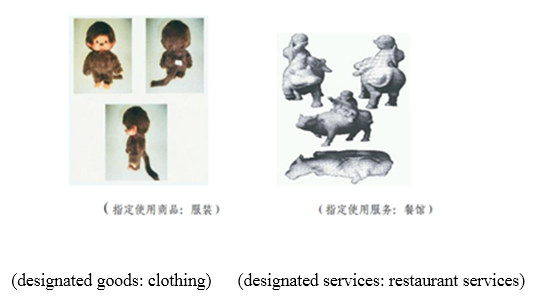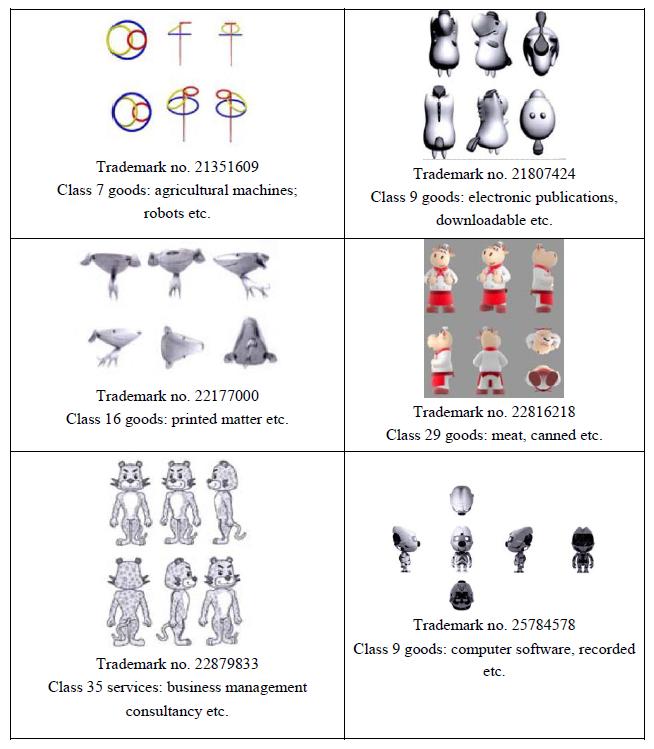I. Concept and type of three-dimensional marks
According to Article 8 of China’s
Trademark Law, any sign capable of distinguishing the goods of a natural person, a legal person, or any other organization from those of others, including but not limited to word, design, letter, numeral, three-dimensional symbol, combination of colors, and sound, as well as a combination of the above, may serve as a trademark for registration application. Three-dimensional mark, just as its name implies, is a kind of trademark that is comprised of three-dimensional symbols or three-dimensional symbols containing other types of symbols. Typical three-dimensional trademarks are basically classified into the following two types: one is a kind of trademarks using the shape of the goods itself or their packages in the form of three-dimensional symbols as the trademark representations when they are applied for registration. The other one is a kind of trademarks using the three-dimensional symbols other than the shape or packages of the goods as their representations.
II. Registrable three-dimensional marks
In practice, trademark authorities and courts of justice mainly hold the following opinions in individual cases when it comes to registrability of different types of three-dimensional marks:
1. Three-dimensional symbols of shapes or packages of the goods are generally identified as not having inherent distinctiveness, burden of proof borne by the applicant to prove the distinctiveness through use of mark is high.
Due to the fact that this kind of symbols directly show shapes or packages of the goods while relevant consumers lack the habit of identifying the origin of goods by shapes or packages, three-dimensional marks are usually not considered as having inherent distinctiveness. Therefore, trademark authorities are generally quite strict in examining such marks to avoid the situation in which some applicant tries to monopolize a three-dimensional shape commonly used in an industry for products or packages by registering it as a trademark. An application for registration of a three-dimensional mark often undergoes a lengthy process of preliminary examination, substantive examination, review of refusal, and administrative litigation, and very few three-dimensional marks were granted registration.
Is there inherent distinctiveness in the shapes of goods or packages of goods with some originality?
In the
Trademark Examination and Judgement Rules instituted by the China Trademark Office (hereinafter called CTMO) and the Trademark Review and Adjudication Board (hereinafter called TRAB), it stipulated the following:
Three-dimensional shapes of the goods lack distinctiveness if they are universally or commonly used in the industry and are incapable of distinguishing the origins of goods. Exceptions include those that acquired distinctiveness through use, as supported by sufficient evidence.
Three-dimensional shapes of packages universally or commonly used in the industry lack distinctiveness if they are incapable of distinguishing the origins of goods. Exceptions include such three-dimensional shapes that are not universally or commonly used for packages of designated goods, and those that acquired distinctiveness through use, as supported by sufficient evidence.
It can be deduced from the above rules that trademark authorities hold the opinions that the three-dimensional shapes that are not universally or commonly used as the packages of designated goods have distinctiveness. However, for the universally or commonly used packages of designated goods, there are just examples, not any specific standards for determination.
In earlier judicial practices, the courts recognized the unique three-dimensional shapes of goods, for instance:
in the case of ZIPPO lighters, the court held that the overall design of the applied-for mark no. 3031816 owned by American Zippo Manufacturing Company is unique, not conformable to definition of common shape in the relevant industry. Its overall uniqueness makes it distinguishable.

Three-dimensional mark no. G783985 by Zippo Manufacturing Company
In subsequent judicial practices, a few changes took place in the courts’ standards for determining whether the shapes or designs of products having certain originalities are distinctive or not, as demonstrated in the case of Fanta bottle mark no. 3330291. Beijing Higher People’s Court is of the view that the mark in question is the container shape of its designated beverage product, and the originality in design does not prove the distinctiveness of the mark. Unique designs of containers of goods may be protected under copyright law or patent law, but may not serve as the reason for the mark’s inherent distinctiveness.

The three-dimensional mark no. 3330291 by Coca-Cola Company
In the trademark case of Tetra Pak packaging, although the plaintiff alleged that the applied-for mark was originally created by itself and submitted a large amount of evidence of use such as certificates verified by relevant industry associations, contracts, purchase orders and audit reports, and the courts recognized the fact that the plaintiff’s mark had been a high-profile brand through long and extensive use in the liquid dairy and fruit juice fields, the courts of both first and second instances held that the target consumers of the packaged products are not limited to factories manufacturing liquid dairy and fruit juices products, but should include those relevant consumers of designated goods and services, that is to say, manufacturers and operators in the fields of papers, cardboards, cardboard-related products and wrapping papers. Thus the courts held that evidence provided by the plaintiff were not enough to prove the acquired distinctiveness obtained through use which enables the relevant consumers to recognize the origin.
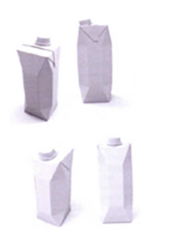
The three-dimensional mark no. 15485959 by Tetra Laval Holdings & Finance S.A.
In the administrative case Wipro Unza Holdings Ltd. vs. Trademark Review and Adjudication Board, the plaintiff alleged that the package of its product has a unique design and submitted a deal of evidence such as product sales data and advertisement expenditure to prove acquired distinctiveness through use. The court held that the relevant design parts of the mark in question are merely local detailed features and the relevant consumers lack the living habit of identifying the origin of such goods through packaging containers. Therefore, as a three-dimensional symbol in the form of a packaging bottle, the applied-for mark lacks identification function of distinguishing the origin of goods.
In this case, Wipro Unza Holdings Ltd. asserted that it had acquired patent right for the industrial design and thus the mark using the design has novelty and uniqueness. It also submitted evidence of decision made by a Guangdong trial court in favor of its design patent. As such, the court of second instance confirmed in the decision that industrial designs and trademarks are not the same in functionality, and having obtained design patent protection does not necessarily indicate the distinctive features required in trademark registration.
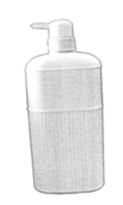
The three-dimensional mark no. 7688821 by Dongguan Unza Commodities Limited
The article 9 of the
Provisions of the Supreme People's Court on Certain Issues Concerning Administrative Cases of Grant and Sole Ownership Attribution of Trademark Right, implemented as of the year 2017, confirmed the opinions of the court in the above-stated case, which denies three-dimensional symbols with such originality inherent distinctiveness:
Article 9 – The applied-for three-dimensional marks, reliant on only shape or partial shape of goods and reluctant to be identified as symbols denoting origin of goods by relevant public, are deemed not to have distinctive features as presumably contained by eligible trademarks.
The shape as contained in the mark being originally created and used by the applicant at the earliest does not certainly lead to itself having the distinctive features as a trademark.
The so-called symbols of first clause in the article having been used long and extensively, by which relevant public could distinguish the origin of goods, may be identified as symbols with distinctive features.
A quick search of decisions of review of refusal published by TRAB revealed the following trademarks objected for lack of distinctiveness at the stage of review of refusal examination:
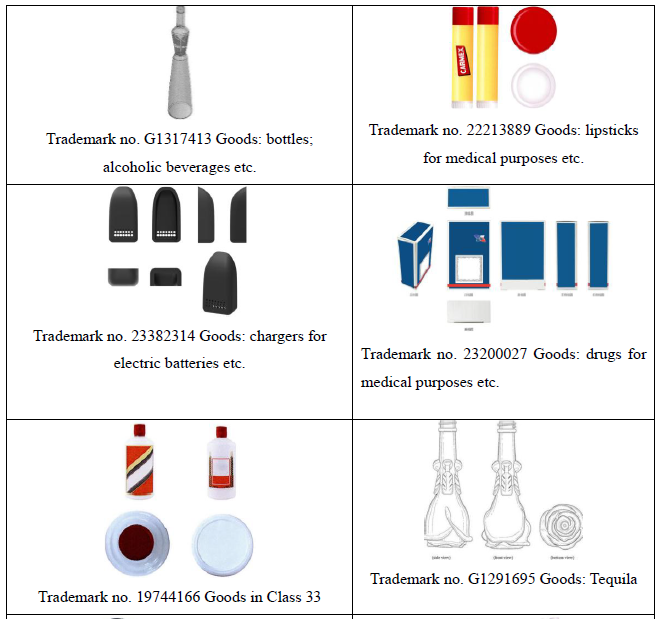
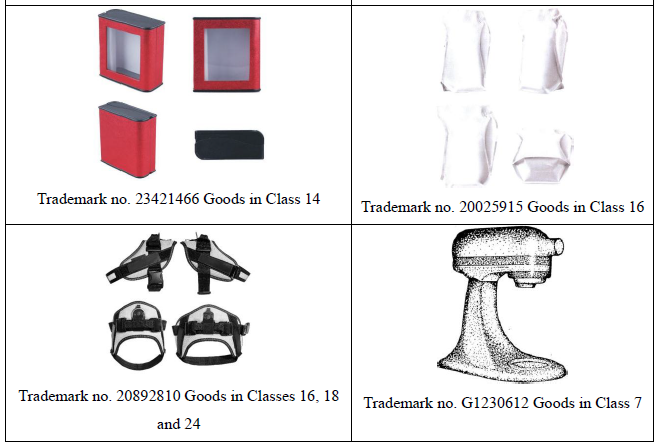
Source: CTMO official website
http://sbj.saic.gov.cn/sbcx/
As for this kind of three-dimensional marks, they are granted registration on the ground that they do not directly indicate shapes of goods or other features. But they may still be rejected when used in certain classes, for instance, trademark no. 21902204 for designated goods in classes 18, 25 and 28. Representation of the mark is as follows:
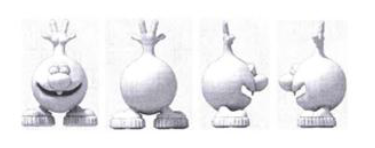
Trademark no. 21902204
This mark has been granted registration on the goods “leather bags; school bags” in class 18 and “clothing” in class 25, but has been objected on the goods “toys” in class 28 due to lack of distinctiveness. The reasoning is that this three-dimensional mark used on the toys is much more like toys themselves than a mark for the product.
Likewise, the trademark no. 24441028 has been partially objected by the CTMO on the goods “robots (mechanicals)” in class 7 and “Humanoid robots with artificial intelligence” in class 9:
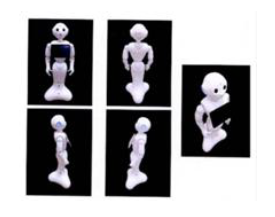
Trademark no. 24441028
Although the above cases show that three-dimensional marks comprised of elements other than shapes and packages of goods or elements that do not directly describe features of goods are easier to get registered, in some other cases, whether three-dimensional symbols consisting of elements other than shapes or packages of goods possess inherent distinctiveness remains controversial.
For example, in the case of review of refusal concerning bear TOUS, the CTMO rejected the trademark application for lack of distinctiveness. The TRAB also believed that the overall appearance and visual effect of the three-dimensional symbol of bear TOUS is not much different from other typical three-dimensional symbols of bear and thus lack distinctiveness when used on the goods “trunks and travelling bags; umbrellas”. The court of first instance is of the view that use of the mark in question very likely results in relevant consumers believing that the mark is part of goods decoration and not identifying the mark as a trademark. The court of second instance overturned the rule and held that the three-dimensional symbol of bear TOUS possesses inherent distinctiveness. The court of second instance further held that the mark itself is not functional and has nothing to do with its designated goods. Thus, the court of second instance ruled that the three-dimensional symbol of bear does possess inherent distinctiveness, considering factors such as whether the mark has the functionality of indicating and distinguishing the origin of goods, what the business cognition of relevant public, and how the mark in question is used in real market.
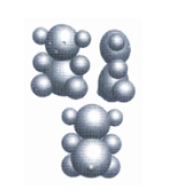
Trademark no. G1047061 (int’l reg.) registered by S.TOUS,S.L. Goods: class 18 trunks
and travelling bags; umbrellas, class 25 clothing, footwear
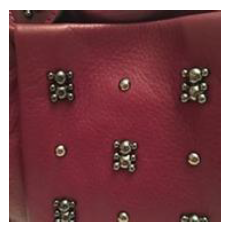
The way the mark bear TOUS is used on the goods
Above all, there are difficulties for the three-dimensional trademarks, especially trademarks comprised of shapes of goods or packages of goods to get registered. Originalities as contained in the three-dimensional symbols are one of the prerequisites that make registration of the marks possible. However, even for those three-dimensional symbols that have originality, the applicants still need to submit extensive evidence to prove that the mark has acquired distinctiveness through use. The less unique a three-dimensional mark is, the much more burden of proof the applicant has to bear.
III. How to prove distinctiveness for three-dimensional trademarks
As for three-dimensional trademarks existing in the form of three-dimensional symbols, it is not as easy as it may be to prove cognition situation by relevant public as for the word marks which involves directly submitting evidence of publicity, media coverage, sales contracts or agreements, and sales invoices. Furthermore, use of the three-dimensional mark is usually combined with word and figurative marks; therefore, it is difficult in reality to prove whether the relevant public could identify the origin of goods by using merely the three-dimensional shapes without the help from words and devices.
Although relevant public’s cognition of three-dimensional marks could be proved by means of market survey, the definition of relevant public is usually so broad that one market survey could not cover the whole crowd of relevant public. As a result, market survey is time-consuming and requires lots of efforts, and trademark authorities and courts of justice are usually skeptical about the objectivity and accuracy of the survey results.
How should we prove that three-dimensional marks have acquired distinctiveness through usage? This question is usually a headache that the applicant is confronted with. The following cases may give a few clues:
1. The case of review of refusal concerning three-dimensional mark “Head & Shoulders”
The shampoo bottles of “Head & Shoulders” (hereinafter called H&S) are product packages that Chinese consumers are very familiar with. Relevant Chinese public could tell that the products are from the Procter & Gamble Company (hereinafter called P&G Company) from the special packaging. Blue lids and streamlined bodies of H&S shampoo bottles are highly recognizable to Chinese consumers.

Packaging bottles of H&S shampoos
P&G Company filed, on February 19, 2016, with the CTMO an application for registration of a three-dimensional mark no. 19119659 for the goods “hair wash preparations” etc. in class 3. The CTMO objected this application on the ground that the three-dimensional symbol as contained in the mark is a design of common packages of goods and lacks distinctive features and cannot function to distinguish the origin of goods when used as a trademark, which violates 3
rd item of clause 1 of Article 11 of the
China Trademark Law. On December 23 of that year, P&G Company, not satisfied with the CTMO’s decision, filed for review of refusal with the TRAB. On December 1, 2017, the TRAB made a review decision that the trademark application for the goods “shampoos, hair wash preparations, hair conditioners, dry shampoos” was preliminary approved for publication.
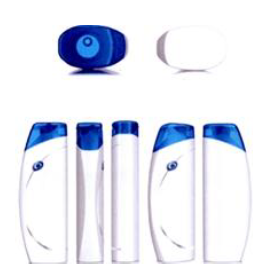
Representations of the mark no. 19119659
The applicant submitted the following evidence in the review:
●
Brand history introduction about brands “Head & Shoulder” and “海飞丝(Head & Shoulders in Chinese characters)” of the applicant; Information of external packaging of products of the brands “Head & Shoulder” and “海飞丝(Head & Shoulders in cc)”; brief introduction of series products of the brands “Head & Shoulder” and “海飞丝(Head & Shoulders in cc)” on official website;
●
Web search pages with “海飞丝(Head & Shoulders in cc)” and “洗发水(Shampoo in cc)” as keywords;
●
The publicity and media coverage of the applicant and its “海飞丝(Head & Shoulders in cc)” products by internet media;
●
Brand enforcement information;
●
Sales statistics, publicity videos and pictures about series products of the brands “Head & Shoulder” and “海飞丝(Head & Shoulders in cc)”.
The TRAB pointed out in the review decision that the mark “Head & Shoulder” and “海飞丝(Head & Shoulders in cc)” registered and used by the applicant on the goods “washing-up supplies” was listed in the “National Key Trademark Directory of Protection” issued by the Trademark Office in April 1999 and June 2000. In December 2003, the marks “Head & Shoulder” and “海飞丝(Head & Shoulders in cc)”used on the goods “shampoos” was officially identified as famous trademarks by Guangzhou Administration Bureau for Industry and Commerce. In the year 2015, the applicant’s mark nos. 344695 and 1580242 “海飞丝(Head & Shoulders in cc)” used on the goods “hair conditioners, shampoos” and “hair wash preparations, hair conditioners” in class 3 respectively were identified as well-known marks by the TRAB’s in a review case.
The TRAB confirmed the following:
the three-dimensional shape of the bottles of the applied-for mark were shapes of packages of the goods “shampoos, hair conditioners, hair wash preparations, dry shampoos” has acquired certain fame in the relevant market after being used long and extensively by the applicant. The overall shape of the bottle is unique, the left side being streamlined, slightly thinner than the right side. The cap has an exclusive blue color, with an irregular shape thereof. Plus the facts in the TRAB’s findings, the applicant’s mark “海飞丝(Head & Shoulders in cc)” has made a well-known mark used on the goods “hair conditioners, hair wash preparations, shampoos”. With the products being in high fame and reputation, external packages of the products are an indivisible part. When seen by the relevant public, the three-dimensional symbol can be used by them as a badge of origin to distinguish the source of goods and established direct connections to the applicant. Thus, the applied-for mark possesses distinctive features as required to be an eligible mark when used on the goods “hair conditioners, hair wash preparations, shampoos, dry shampoos” and does not violate 3rd item of clause 1 of Article 11 of the China Trademark Law.
As can be seen from the case, the evidence submitted by the applicant at the review stage were mainly those proving use, fame and reputation, and protection of the word marks “Head & Shoulder” and “海飞丝(Head & Shoulders in cc)”. Moreover, when making the final review decision, the TRAB referred to records of trademark enforcement protection made favorable to the applicant by trademark authorities, including records of protection as well-known and famous marks. In the review decision, on the basis that packages of shampoo bottles of the mark “海飞丝(Head & Shoulders in cc)” have certain originalities and distinctiveness, the TRAB holds the opinions that with the products being in high fame and reputation, external packages of the products are an indivisible part, from which it deduces that the applied-for mark have presumably distinctive features when used on the goods “shampoos, hair conditioners, hair wash preparations, dry shampoos”. Accordingly, this shows that when examining this review of refusal case concerning the three-dimensional mark, the TRAB takes into consideration the unique design of the shampoo bottles of the mark and also combines the same with the use as well as fame and reputation of the word marks shown on packages of the products.
2. The administrative litigation case against review of refusal decision concerning the three-dimensional mark of Dior perfume bottles
The case of Dior perfume bottle three-dimensional trademark retrial is one that has caught relatively high attention among recent three-dimensional trademark cases in China. Although the trademark involved in this case has not yet been finally registered, opinions of the appellant, the respondent and the Supreme Court judge are worthy of attention on distinctiveness of the three-dimensional trademarks as indicated in the process of trial.
J’ADORE series perfumes of PARFUMS CHRISTIAN DIOR (hereinafter-called Dior Company) have certain fame and reputation with its perfume bottles having certain features:

On August 8, 2014, Dior Company recorded registration of trademark no. 1221382 in Trademark Registry of Internal Bureau of World Intellectual Property Organization designating extension of protection to China, for designated goods “perfumes” in class 3.
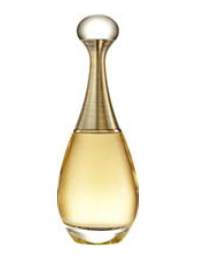
International Registration No. 1221382
Citing the 3
rd item of clause 1 of Article 11 of the China Trademark Law, the CTMO objected the trademark application for lack of inherent distinctiveness. It was also objected in the subsequent proceedings review of refusal by TRAB, administrative litigation case by the court of first instance, appellant case by the court of second instance.
Dior Company applied to the Supreme People's Court for retrial. The Supreme People’s Court accepted the case and made a retrial judgment, cancelling the objection decisions made by the TRAB, courts of first instance and second instance and ordering the TRAB to re-make a review decision.
As for issue of distinctiveness of the mark involved in this case, the appellant asserted the following:
Design of the J’ADORE perfume products is unique; the appellant has obtained registration of the identical mark no. 7505828 for the goods in class 3; uniqueness of design of the J’ADORE perfume bottles in the field of perfume products and the relevant industry is generally recognized by relevant public and the design of the bottles had established direct connections to the appellant. The respondent should bear the burden of proof regarding this point. Color is one of composing elements of a trademark, but lower courts’ judges had not taken the color into consideration. Moreover, even if the color is omitted, the mark is still distinctive. The applied-for mark had been well-known by Chinese consumers through long and extensive use, and Chinese consumers could distinguish by the mark that the relevant perfume products are from the appellant.

Representation of the registered mark no. 7505828 by the appellant Goods: ethereal oils etc.
To prove use of the applied-for mark, the appellant asserted the following facts, and submitted relevant evidence as support:
The applied-for mark was launched in China in the year 1999 and used on the J’ADORE series products that make use of the design of packages involved in this case; J’ADORE perfumes were already extensively reported by Chinese media in the year 2001; the design of the perfume products won the grand award of FIFI in the same year, an award of Oscar in the perfumes industries and the bottle design played an important role in the winning; in 2008, market share of the appellant’s perfume products ranked first in the Chinese market, being one of best-seller perfume products ten years in a roll, with an annual advertising investment of over RMB100million in the past ten years; the appellant’s perfumes were awarded grand beauty award by famous domestic media of China from the year 2011-2016; the appellant’s products long and extensively promoted and sold in over 10 cities in China, as supported by evidence of sales contracts and agreements and corresponding invoices from the year 2010-2016. Publicity of J’ADORE perfumes were extensively conducted by periodicals, magazines, Internet and other kinds of media, covering over 10 cities in China; national library search results with the keywords “J’ADORE” and “迪奥真我(Dior J’ADORE in Chinese characters)” were provided.
Although the Supreme People’s Court did not give a final affirmation on the distinctiveness issue of the applied-for trademark in the retrial judgment, it pointed out that the TRAB should consider the following points when re-issuing a decision:
First point is distinctiveness of the applied-for mark and acquired distinctiveness through use. Second point is consistency principle in the review examination rules. In light of the mark which is identical to the mark involved in this case being registered, the lower courts should not overlook the consistency principle just because of the single case examination rules.
Whether the application for the trademark in this case can be finally registered depends on the re-examination of the TRAB and the final result of the follow-up procedures. However, it is worth noting that in this case the appellant claimed that the three-dimensional trademark no. 7505828, which is identical to the mark in this case, was approved for registration by the CTMO, and that the application for the trademark in this case should also get registered and protected based on the consistency of the examination standards. Due to the past practice of the CTMO, the overall distinctiveness of the three-dimensional trademark containing portion of the distinctive text was recognized. Therefore, the three-dimensional trademark no. 7505828 containing text part of J’ADORE should not be rejected and should be granted registration instead. According to recently amended
Trademark Examination and Judgement Rules, unless the applicant voluntarily disclaims exclusive right of the non-distinctive part of three-dimensional symbol as contained in the mark at the time of responding to Office Action, the CTMO will reject the trademark application based on the three-dimensional symbol lacking distinctiveness when examining the composition trademark comprised of non-distinctive three-dimensional part combined with other distinctive elements.
For the applied-for trademark not containing the text part in this case, the Supreme People’s Court held that the three-dimensional trademark, of which the appellant had obtained the registration, can be used as a reference factor for registration of the trademark in this case, and should not be simply rejected based on the case-by-case principle. Whether the TRAB will consider referring to the three-dimensional trademark prior registered by the same applicant when re-issuing a review decision is still subject to further observation.
Additionally, the appellant, in this case, provided evidence of actual use of the applied-for mark labelled with text parts “J’ADORE” and “迪奥真我(Dior J’ADORE in Chinese characters)” in the form of advertisements, publicity and coverage, awards bestowed upon products, sales statistics so as to prove acquired distinctiveness through use of the mark. Whether the three-dimensional mark can be granted registration, it remains to be seen.
IV. Conclusion
The application for registration of a three-dimensional trademark is currently a big issue in procedures of trademark registration. There are no universal standards for the conditions required for registration of a three-dimensional trademark and for means of proving acquired distinctiveness through use. We need further clarification by the competent trademark authorities and courts of justice. I hope this article can help you, more or less, to better understand the issue of three-dimensional trademark registration.
References and citations:
1. Analysis of identification on distinctiveness of three-dimensional marks by Shujie Feng, periodicals
Law, issue 6, 2014
2. In-depth analysis! the issue of distinctiveness of three-dimensional marks by CHOFN IP WeChat official account, April 27, 2016
3. Judgements on acquired distinctiveness of three-dimensional marks---Judges’ interpretations on classical trademark cases by Huibin Yu, China Industry and Commerce Press
4. Judgements on distinctive features of three-dimensional marks---Wipro Unza (Guangdong) Commodities Co., Ltd. vs. Trademark Review and Adjudication Board of State Administration for Industry and commerce---Beijing courts of justice judges’ reviews on hard cases (volume 4), Law Press • China
5. Judgements on inherent distinctiveness of three-dimensional trademarks--- Administrative litigation case against review of refusal decision of S.TOUS, S.L. vs. Trademark Review and Adjudication Board by Lingling Zhang, China Trademark Periodicals WeChat official account, August 21, 2018
6. Notification of review of refusal decision against the three-dimensional trademark no. 19119659, Trademark Review and Adjudication Board official website
7. Final adjudication! chief justice Kaiyuan Tao from the Supreme People’s Court held hearings and adjudicated today on the case of three-dimensional mark of PARFUMS CHRISTIAN DIOR, IP World WeChat official accont, April 26, 2018
8. Reviews on distinctiveness issue of three-dimensional marks from the perspective of examined cases, Dan Lin, Trademark Examination Cooperation Center official website







